Abstract: From the publisher: More than one fifth of all the known life forms on this planet are beetles. The Book of Beetles takes an in-depth look at 600 significant examples. They are shown in glorious photographs, life-size and in detail, alongside an engraving offering a side or open-winged view. Each profile includes a population distribution map, a table of essential information, a commentary revealing notable characteristics, a list of related species, and a diagnosis of the specimen's importance in terms of taxonomy, rarity, behaviour and scientific significance.
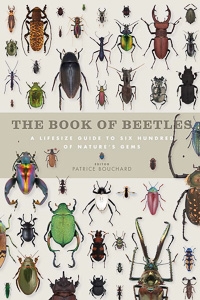 |
| Front Cover |
Patrice Bouchard, general editor of The Book of Beetles, is a research scientist and curator of Coleoptera at the Canadian National Collection of Insects, Arachnids, and Nematodes, and co-author of four books, including the award-winning Tenebrionid Beetles of Australia.
More than one fifth of all the known life forms on this planet are beetles. They are extraordinarily visually diverse: the famous British geneticist J.B.S Haldane, when asked what could be inferred about God from a study of His works, replied, 'An inordinate fondness for beetles.'
The Book of Beetles takes an in-depth look at 600 significant examples. They are shown in glorious photographs, life-size and in detail, alongside an engraving offering a side or open-winged view. Each profile includes a population distribution map, a table of essential information, a commentary revealing notable characteristics, a list of related species, and a diagnosis of the specimen's importance in terms of taxonomy, rarity, behaviour and scientific significance.
This is a substantial and beautifully produced book that I would love to be able to recommend, especially as it has the added merit of being affordable. The thing is, I am not quite sure who I am recommending it to, or indeed, what exactly it is. For that reason, I shall begin by describing it.
As the subtitle indicates, the bulk of the book consists of a guide to 600 beetles from around the world. Each is illustrated three times: firstly, there is a small line drawing showing the beetle in a natural, living stance; secondly, a lifesize photograph of a set specimen (though unlike set butterflies, without any visible pin); thirdly, and dominating each page, the same photograph significantly enlarged to reveal more detail. All the photographs are from vertically above the beetle, visually flattening many species' curves and protuberances, and I have to say that for me the line drawings, from an oblique angle, are the best part of the illustrations. These show creatures that look like beetles and give a feel for the character of the insects and of the family or subfamily each represents. In addition to the illustrations there is for each species a standardised table listing its family, subfamily, distribution, habitat and feeding habits, as well as a world distribution map, a brief account of some of the beetle's particularities and notable features, and finally a reference to related species, setting it in some kind of a context.
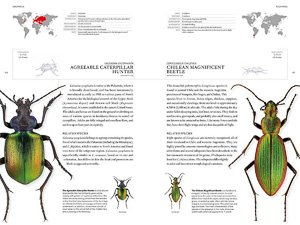 | 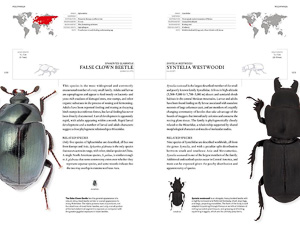 |
So far, so good. But there are around 400,000 named beetle species in the world (not to mention the estimated hundreds of thousands of still unnamed species) so the 600 chosen for inclusion, though all significant in their own way, represent a mere 0.15% of the lot. If you used a similar percentage to illustrate the butterfly world you would be restricted to just 30 butterflies. Perhaps the comparison is unfair; but the reader is nevertheless left wondering what the species descriptions are for. Learning that the Ten-lined June Beetle (from America) feeds on the needles of Ponderosa Pine is a little like learning that Mr. J. Smedbury, of Brompton Road, Chester, has a collection of porcelain fairies - interesting, in its own way, but sort of arbitrary. There is a list of beetle families at the end of the book and each of the four suborders is introduced with an informative overview, but there is no real attempt to guide the reader through the big picture - just 600 micro-pictures. This is not necessarily a criticism - more an oddity. You will not buy this book to identify beetles, nor to understand the taxonomic relationships between the groups, nor really to learn very much about beetle biology, though there is a concisely informative section on this at the beginning. You will buy it to get, quite literally, glimpses into their world. Many of the glimpses are fascinating, but all are only tasters.
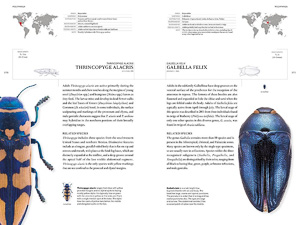 | 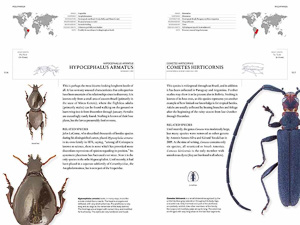 |
In short, this is a good book, packed with information, but not a book with any obvious practical function for the naturalist. Six hundred beetles, representing almost all the beetle families but a tiny percentage of beetle genera and species, are thrust under your nose in glorious technicolour, reminding you that Mother Nature is prodigious, imaginative, sometimes surreal and always meticulous in her attention to detail. In a world obsessed with gadgets and the more limited products of human imagination, this is a very important reminder. Children should grow up surrounded by books like this.
The book can be ordered from the publisher, Ivy Press.